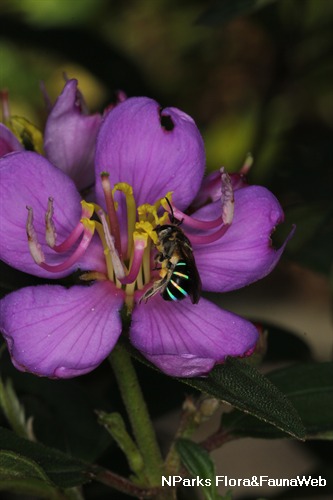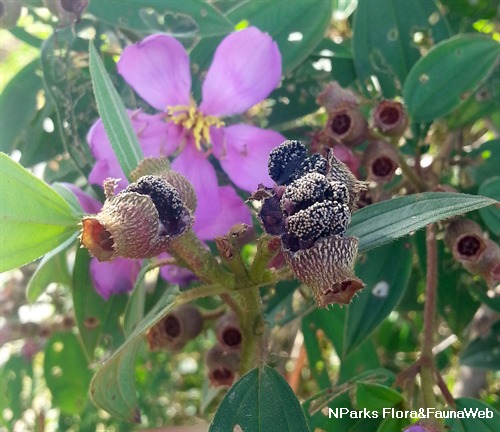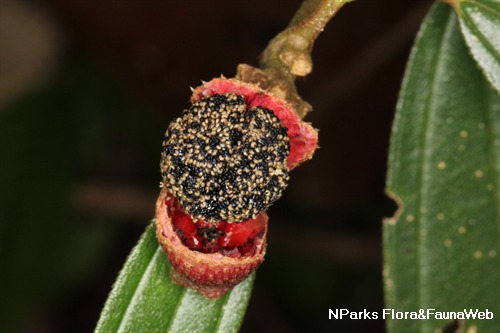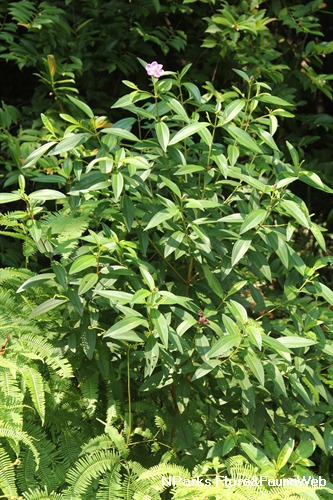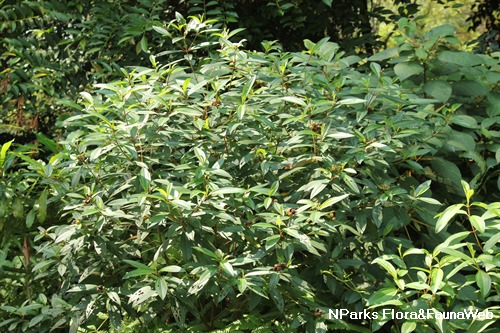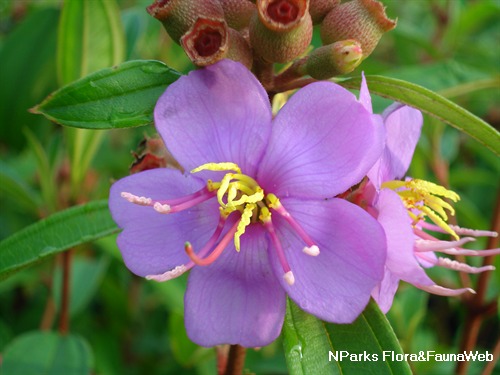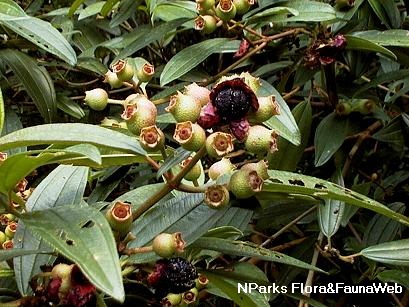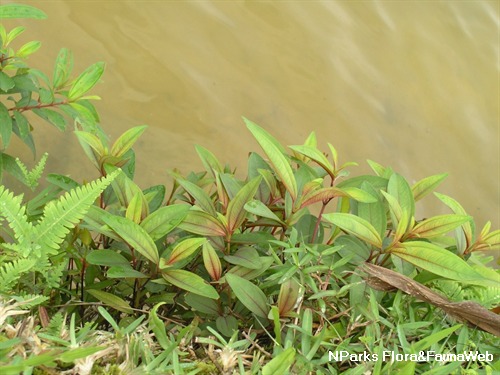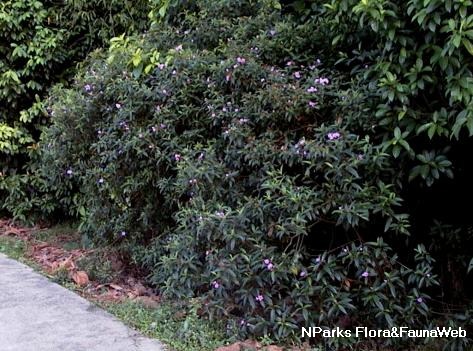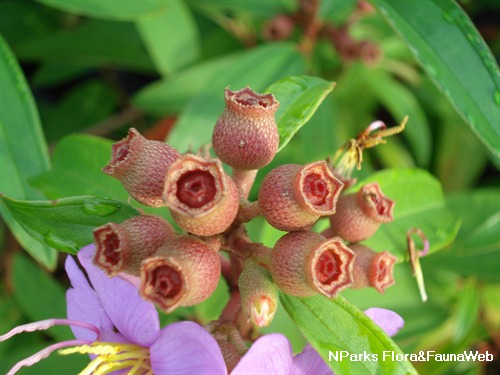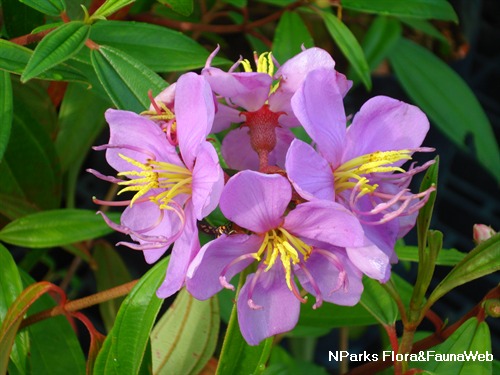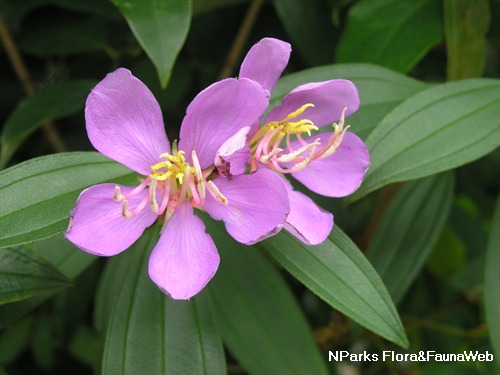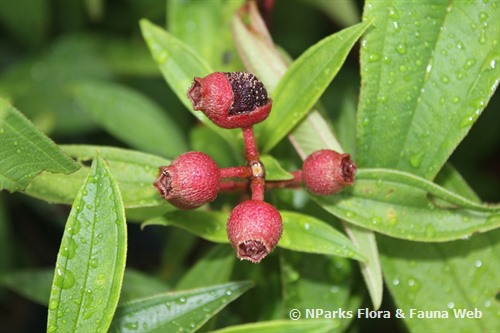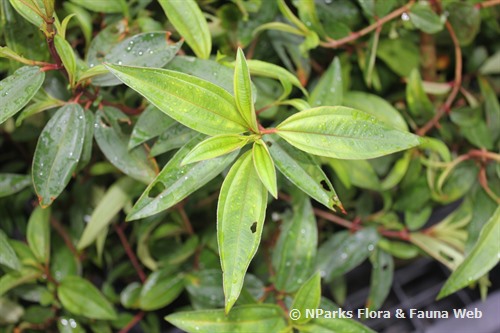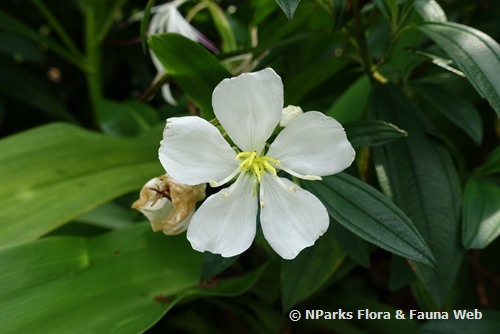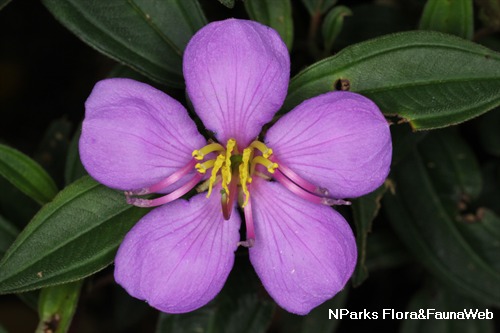
Back
Melastoma malabathricum L.
| Family Name: | Melastomataceae |
| Common Name: | Common Sendudok, Singapore Rhododendron, Indian Rhododendron, Sesenduk, Malabar Gooseberry, Straits Rhododendron, Sendudok, Senduduk, 野牡丹 |
Name
Classifications and Characteristics
| Plant Division | Angiosperms (Flowering Seed Plants) (Dicotyledon) |
|---|---|
| Plant Growth Form | Shrub, Tree (Shrubby (1m-5m)) |
| Lifespan (in Singapore) | Perennial |
| Mode of Nutrition | Autotrophic |
| Plant Shape | Irregular |
| Maximum Height | 1 m to 5 m |
Biogeography
| Native Distribution | Indian Ocean, China, Taiwan, south and Southeast Asia (including Singapore), Australia, and the south Pacific |
|---|---|
| Native Habitat | Terrestrial (Secondary Rainforest, Grassland / Savannah/ Scrubland, Disturbed Area / Open Ground, Mountain) |
| Preferred Climate Zone | Tropical, Sub-Tropical / Monsoonal |
| Local Conservation Status | Native to Singapore (Least Concern (LC)) |
Description and Ethnobotany
| Growth Form | It is a shrub or small tree up to 5 m tall. Its stems reddish, covered with small scales. |
|---|---|
| Foliage | Its opposite, stalked leaves have leaf blades that are lance-shaped, 2–15 by 0.6–6.5 cm, and bear three prominent veins–one central and two marginal. Leaves are bristly on the underside. |
| Flowers | Its flowers are up to 8 cm wide, with petals that are light to dark magenta-pink, or occasionally white. |
| Fruit | Its 6–10 mm-wide fruits are somewhat round, and open irregularly when ripe to expose dark blue pulp with many orange seeds. The fruits are edible but rather tasteless, with the pulp staining the tongue blue-black. |
| Others - Plant Morphology | It is a pioneer species frequently found in wastelands and secondary forests. It can tolerate poor soils and is considered as weedy or invasive in some countries. |
| Habitat | It grows in open sites, in the lowlands and on mountains up to 3,000 m altitude. |
| Associated Fauna | It is pollinated mainly by bees and wasps, but occasionally by butterflies, too. Fruit is eaten by butterflies, birds, squirrels and monkeys. |
| Cultivation | It can be propagated by seed or stem cutting. |
| Etymology | Genus name ‘Melastoma’ means ‘black mouth’ in Greek, a reference to the dark-coloured pulp. |
| Ethnobotanical Uses | Edible Plant Parts : Edible Fruits, Edible Leaves, Edible Seeds Food (Fruit or Vegetable): Young leaves eaten raw or cooked, taste sour. Pulp around seeds also eaten in Indonesia. Medicinal: Scientific Evidence of Medicinal Properties In pre-clinical trials, Common Sendudok showed pain-relieving (Sulaiman et al., 2004), anti-cancer (Balamurugan et al., 2013), anti-diabetic (Balamurugan et al., 2014), anti-inflammation (Zakaria et al., 2007), antioxidant (Verma et al., 2016), and cholesterol-lowering properties (Balamurugan et al., 2014) in animals. Traditional Medicinal Uses Research supports the traditional use of Common Sendudok to relieve pain and reduce inflammation. Other traditional uses include using the bark to treating dysentery and toothache. A decoction of the leaves is used to treat diarrhoea, dysentery, indigestion, leucorrhoea, stomachache, piles, thrush, and weeping sores from insect stings. The leaves can be applied to cuts, painful arthritic joints, swellings and wounds too. The leaves are also made into a wash for ulcers and to prevent scarring from smallpox. The powdered leaves and roots may be applied on haemorrhoids and wounds. The roots may be used as a mouthwash for toothache. It is important to note that some therapeutic effects from traditional medicinal uses of plants are not currently supported or verified by scientific research.
Others: Leaves fed to silkworms in certain areas. Seeds used to produce a black dye, while the roots a pink dye. |
Landscaping Features
| Landscaping | It is grown as an ornamental plant for its attractive pink or white flowers, in borders or hedges. |
|---|---|
| Desirable Plant Features | Ornamental Flowers |
| Landscape Uses | General, Suitable for Roadsides, Parks & Gardens, Small Gardens, Riverine, Flowerbed / Border |
| Thematic Landscaping | Naturalistic Garden, Wildflower Garden, Butterfly Garden, Bird & Wildlife Garden |
| Usage Hazard - Cons | Invasive / Potentially Invasive |
| Usage Hazard - Cons Remarks | Considered weedy. May form thick thickets. |
| Plant & Rootzone Preference or Tolerance Remarks | Moist soil. |
Fauna, Pollination and Dispersal
| Fauna Pollination Dispersal Associated Fauna | Bird-Attracting (Fruits), Butterfly Host Plant (Leaves), Butterfly-Attracting (Flower Nectar), Bee-Attracting |
|---|---|
| Pollination Method(s) | Biotic (Fauna) (Insects (Bee), Insects (Ant, Beetle, Fly, Thrip, Wasp), Insects (Butterfly, Moth)) |
| Seed or Spore Dispersal | Biotic (Fauna) (Vertebrates (Other Mammal)) |
Plant Care and Propagation
| Light Preference | Semi-Shade, Full Sun |
|---|---|
| Water Preference | Moderate Water, Lots of Water |
| Plant Growth Rate | Fast to Moderate |
| Rootzone Tolerance | Moist Soils, Waterlogged Soils (Drains Site), Easy to Grow |
| Propagation Method | Seed, Stem Cutting |
Foliar
| Foliage Retention | Evergreen |
|---|---|
| Mature Foliage Colour(s) | Green |
| Mature Foliage Texture(s) | Hairy / Hirsute, Rough, Raised / Sunken Veins |
| Foliar Type | Simple / Unifoliate |
| Foliar Arrangement Along Stem | Opposite |
| Foliar Attachment to Stem | Petiolate |
| Foliar Shape(s) | Non-Palm Foliage (Lanceolate) |
| Foliar Venation | Pinnate / Net, Parallel |
| Foliar Margin | Entire |
| Leaf Area Index (LAI) for Green Plot Ratio | 4.5 (Shrub & Groundcover - Dicot) |
Floral (Angiosperm)
| Flower & Plant Sexuality | Bisexual Flowers |
| Flower Colour(s) | Pink, Purple |
|---|---|
| Flower Grouping | Cluster / Inflorescence |
| Flower Location | Terminal |
| Flower Symmetry | Radial |
| Flowering Period | Free-Flowering |
| Flower Lifespan on Plant | 1 Day |
| Flowering Habit | Polycarpic |
Fruit, Seed and Spore
| Mature Fruit Colour(s) | Black |
|---|---|
| Fruit Classification | Simple Fruit |
| Fruit Type | Fleshy Fruit , Non-Accessory Fruit |
References
| References | Balamurugan, K., Nishanthini, A. & Mohan, V.R. (2013). Anticancer activity of ethanol extract of Melastoma malabathricum L. leaf against Dalton's ascites lymphoma. Journal of Pharmaceutical Sciences and Research 5(5): 111–114. Balamurugan, K., Nishanthini, A. & Mohan, V.R. (2014). Antidiabetic and antihyperlipidaemic activity of ethanol extract of Melastoma malabathricum Linn. leaf in alloxan induced diabetic rats. Asian Pacific Journal of Tropical Biomedicine 4: S442–S448. Sulaiman, M.R., Somchit, M.N., Israf, D.A., Ahmad, Z. & Moin, S. (2004). Antiociceptive effect of Melastoma malabathricum ethanolic extract in mice. Fitoterapia 75(7–8): 667–672. Verma, A., Bhatt, P.C., Kaithwas, G., Sethi, N., Rashid, M., Singh, Y., Rahman, M., Al-Abbasi, F., Anwar, F. & Kumar, V. (2016). Chemomodulatory effect of Melastoma malabathricum Linn. against chemically induced renal carcinogenesis rats via attenuation of inflammation, oxidative stress, and early markers of tumor expansion. Inflammopharmacology 24: 233–251. Zakaria, Z.A., Raden Mohd. Nor, R.N.S., Hanan Kumar, G., Abdul Ghani, Z.D.F., Sulaiman, M.R., Devi, G.R., Mat Jais, A.M., Somchit, M.N. & Fatimah, C.A. (2006). Antiociceptive, anti-inflammatory, and antipyretic properties of Melastoma malabathricum leaves aqueous extract in experimental animals. Canadian Journal of Physiology and Pharmacology 84(12): 1291–1299.
|
|---|
Image Repository
Others
| Master ID | 927 |
|---|---|
| Species ID | 2221 |
| Flora Disclaimer | The information in this website has been compiled from reliable sources, such as reference works on medicinal plants. It is not a substitute for medical advice or treatment and NParks does not purport to provide any medical advice. Readers should always consult his/her physician before using or consuming a plant for medicinal purposes. |

